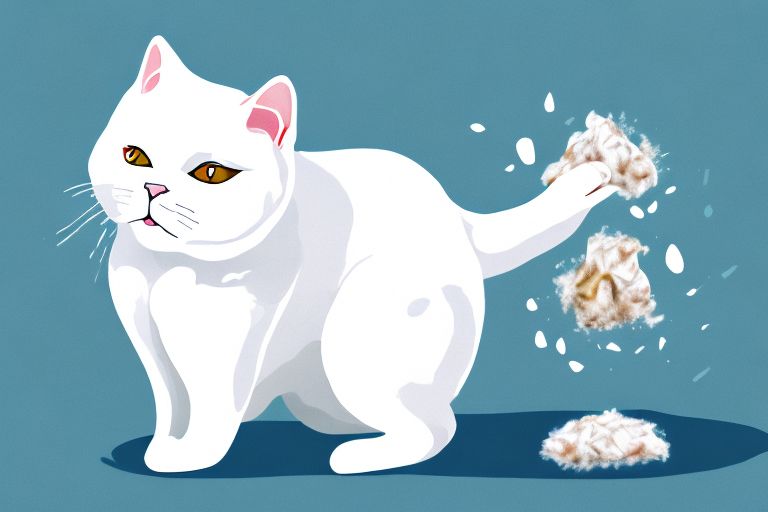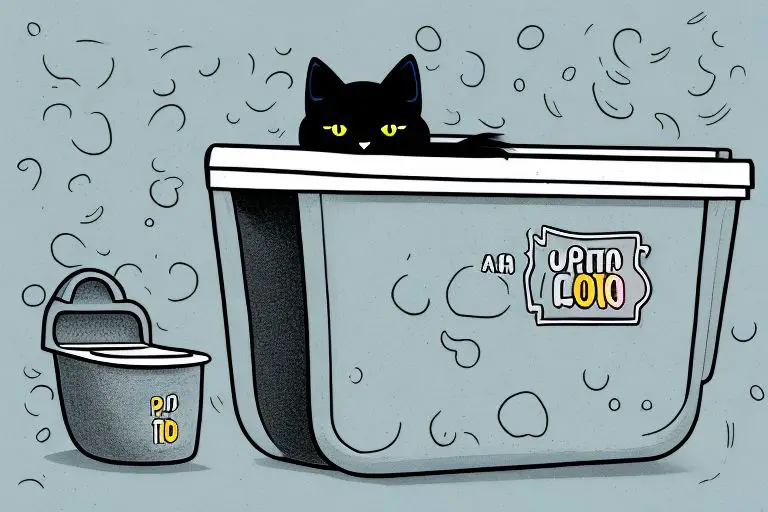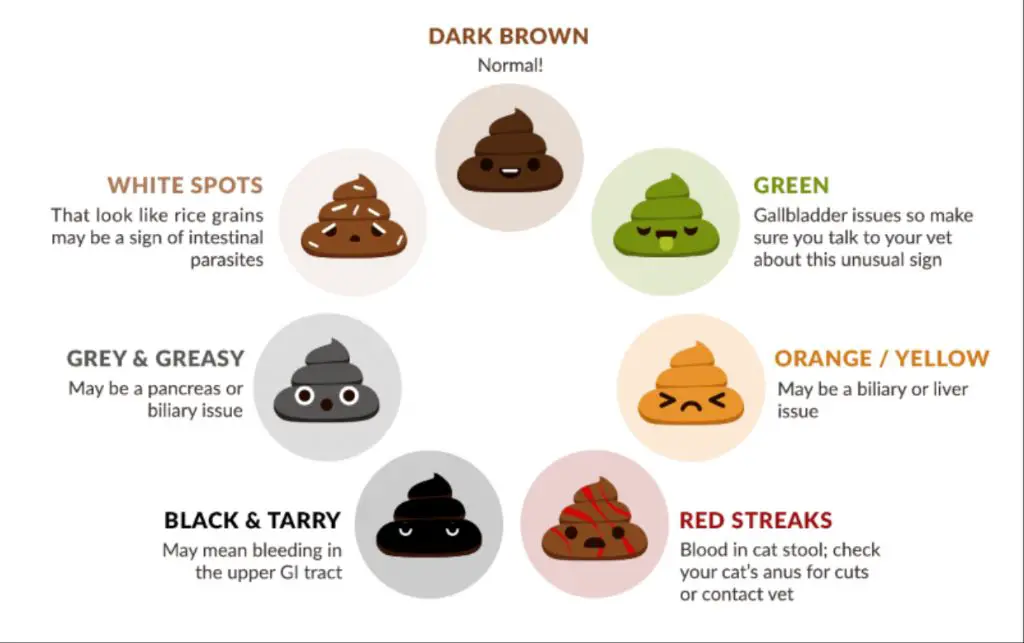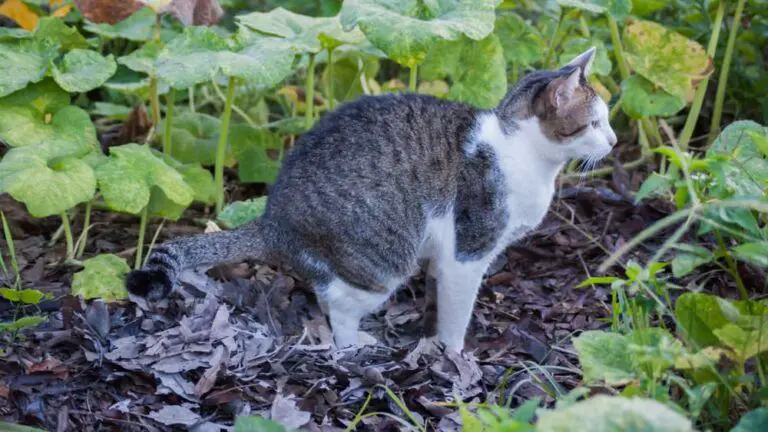Cat feces naturally starts out as some shade of brown when freshly passed. As the stool starts to dry out, the color can change to darker brown, and even near black in some cases. This is a normal process and generally nothing to be alarmed about. However, there are some instances where black stool can signal an underlying health issue that requires veterinary attention.
In this article, we’ll explore the reasons why cat poop sometimes turns black as it dries out. We’ll look at the chemical processes involved, what’s normal vs abnormal, and when black stool is cause for concern. With a better understanding of the factors at play, cat owners can assess if their pet’s feces color changes are routine or a potential red flag.
The Composition of Cat Feces
Cat feces consists of several compounds that give it its typical appearance and smell. The main components are:
- Water – Cat feces contains about 50-75% water, which gives it a soft, moist texture. As feces dries out, the moisture evaporates and the stool becomes firmer and darker.
- Bacteria – Billions of bacteria are present in cat feces, both from the digestive tract and through exposure to the environment. Bacteria aid in the decomposition process as feces ages and dries out.
- Bile pigments – Cats produce a bile pigment called bilirubin, which gives their feces its typical brown color. Bilirubin is a product of red blood cell breakdown. As feces dries, bilirubin oxidizes and turns a darker brown or even black color.
The varying concentrations of these compounds leads to changes in the appearance and odor of cat feces as it dries out and decomposes over time.
Bile Pigments in Cat Poop

There are three main bile pigments found in cat feces: bilirubin, stercobilin, and urobilin. Bilirubin is produced when old red blood cells break down. It gives feces its typical brown color. Bilirubin is excreted into bile and further broken down by gut bacteria into stercobilin and urobilin, which are also pigments that color feces (1).
When bile flow is obstructed or reduced, bilirubin levels build up and less stercobilin and urobilin are produced. This can result in white or clay-colored stools due to a lack of these bile pigments (2). Specific conditions like gallstones, cancer, pancreatitis, or liver disease can cause bile duct obstruction in cats and affect the levels of bile pigments in feces (3).
Oxidation and Drying
One of the main reasons cat feces can turn black is through oxidation as it dries out. Cat poop contains bilirubin, a yellowish bile pigment produced when old red blood cells are broken down. When fresh, this bilirubin gives cat feces its typical brown color.

However, when exposed to air, the iron in bilirubin undergoes oxidation, turning the bile pigment into a darker brown-black color. This process happens more quickly if the feces dries out, as the oxidation occurs faster when the moisture content is lower.
So as cat poop sits exposed to air, the oxidation of bile pigments causes the color to darken from brown to eventually black. The drier the feces, the faster this color change occurs.
Bacterial Decomposition
As cat feces sits exposed to air, bacteria begin breaking it down. Specific bacteria such as Clostridium and Escherichia coli produce enzymes that metabolize bilirubin into stercobilin and other byproducts. This gives old, dried cat feces a dark brown or black appearance. The stercobilin pigment produced is the same as what causes the brown color in normal, fresh stool. However, with oxidation and drying, stercobilin is more concentrated which makes the feces appear darker. The bacterial decomposition also leads to a strong, ammonia-like odor in old cat feces.
Moisture Content
The moisture content of cat feces can affect its color as it dries out. Feces contains bile pigments such as stercobilin and urobilin that give poop its typical brown color. When feces dries out, the pigments become more concentrated which can make the poop appear darker brown or even black (Healthline, 2022).

The moisture content of cat poop depends on the cat’s hydration status and diet. Well-hydrated cats with sufficient water intake will produce feces with higher moisture content. Dehydration leads to harder, dry feces. Diets high in dry kibble and low in canned wet food can also result in drier poop. Drier feces has less moisture to evaporate as it dries out, allowing the bile pigments to become more concentrated and turn the poop black (Gastroconsa, 2021).
transit Time
The time it takes for food to travel through the digestive system, known as the transit time, can impact the color of a cat’s stool. The longer the transit time, the more time the stool spends in the colon, allowing bacteria to act on it before it is excreted.
Slower transit times lead to increased bacterial decomposition and fermentation of the stool. This can cause the stool to turn darker and blacker. Conversely, faster transit times mean the stool spends less time in the colon and has less exposure to bacteria, often resulting in lighter brown or yellow stool.
According to studies, the average transit time for cats is 12-24 hours. However, transit time can vary considerably between individual cats and is influenced by diet, exercise levels, stress, hydration, and gut health.
Cats with chronic constipation or digestive issues like inflammatory bowel disease often have prolonged transit times. This allows more bacterial breakdown of the stool, frequently causing very dark or even black stool.
So in summary, slower gut motility and longer transit times enable greater bacterial action on the stool, which can lead to darker stool colors including black.
Dietary Factors
A cat’s diet can significantly impact the color of its stool. Meat protein is a major component of most cat foods. The digestion of protein can lead to stools that are a normal brownish color. However, an excessive amount of protein in a cat’s diet may cause their stool to turn black or tarry in color. This dark coloration is due to the presence of partially digested blood in the feces, which is not necessarily unhealthy but should be monitored.
Certain medications can also alter the color of a cat’s stool. For example, activated charcoal is sometimes used to treat poisoning in cats and can turn their feces black. Other drugs like Pepto-Bismol contain bismuth subsalicylate, which can make a cat’s poop appear black and tarry. If a cat is on any medications, it’s important to watch for changes in stool color and notify your veterinarian if the change seems abnormal.
In most cases, a change in diet is the primary reason for a change in stool color. Gradually transitioning your cat to a new food over 5-7 days can help avoid digestive upset. Overall, monitoring your cat’s litter box habits can provide insight into their health. If the change in stool color is dramatic or accompanied by other symptoms, consult your veterinarian.
When to Seek Help
It’s important to monitor your cat’s litter box habits and know what is normal vs. abnormal for your pet. Consistently black, tarry, bloody, mucus-laden or unusually foul-smelling feces warrant a veterinary visit. According to Bond Vet, these issues may indicate:

- Intestinal bleeding
- Inflammation
- Infection
- Parasites
- Cancer
- Other serious medical conditions
Bloody stool is considered an emergency. Cats can become seriously ill from blood loss or the underlying cause. Don’t hesitate to get prompt veterinary attention if you notice blood in your cat’s feces.
Green cat poop can also be a cause for concern. According to Rover’s unhealthy cat poop chart, green stool often indicates:
- Dietary issues
- Rapid transit time due to diarrhea
- Bacterial infections
- Parasites
- Feline infectious peritonitis (FIP)
While an occasional off-color poop is normal, recurrent abnormal stool warrants an exam. Contact your vet promptly if your cat produces abnormal feces consistently over 24-48 hours. Providing a fresh stool sample will help diagnose any underlying issues.
Conclusion
In summary, there are several factors that can cause a cat’s poop to turn black as it dries, including:
– Bile pigments in the feces oxidizing and darkening as the poop dries out
– Bacteria breaking down the feces, which can lead to blackening
– Dietary factors like eating black licorice that can cause temporary black color
– Potential medical issues like upper GI bleeds or blood in the stool
In most cases, some darkening and drying of cat poop is normal. However, if the poop is tarry black or the color change is accompanied by other symptoms, it’s a good idea to get your cat checked out by a vet.
With attention to diet, hydration, and litter box hygiene, cat owners can help encourage healthy, normal poops from their feline friends.

